The Western Desert in Egypt is a vast, enigmatic expanse covering about 700,000 square kilometers, approximately two-thirds of Egypt’s land area. Stretching from the Mediterranean Sea south to the Sudanese border and from the Nile River west to Libya, this area is rich in history, natural beauty, and adventure opportunities. With TravMe, you can explore this fascinating region, known for its stunning landscapes and ancient oases. This comprehensive guide will take you through the most captivating aspects of the Western Desert, focusing on the Black and White Deserts.
The Western Desert in Egypt
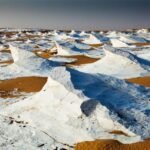
The Western Desert in Egypt is divided into several governorates. In the north and west, the Matrouh Governorate extends from the Mediterranean south, while the New Valley Governorate covers the area to the Sudan border. The eastern parts of the Western Desert fall under Giza, Fayyum, Beni Suef, and Minya Governorates. The desert is home to seven key oases: Siwa, El Faiyum, Bahariya, Farafra, Dakhla, and Kharga, each offering unique experiences and attractions.
1. Siwa Oasis
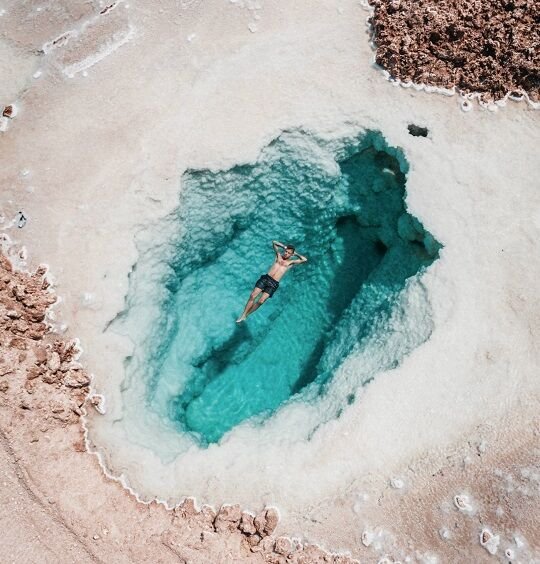
Siwa Oasis is one of Egypt’s most remote settlements, located 560 km from Cairo. Known for its lush palm groves, natural springs, and ancient ruins, Siwa is a haven for those seeking tranquility and history. Key attractions include the Temple of the Oracle, where Alexander the Great is said to have consulted the Oracle, and the Shali Fortress, an ancient mud-brick citadel. The citizens of Siwa speak a distinct language, and the main activities here include farming and handicrafts like basketry. Tourism has become a vital source of income in recent decades.
2. Bahariya Oasis and the Black Desert
Bahariya Oasis, closer to Cairo, is renowned for its golden mummies, ancient tombs, and the Black Desert. The black hills, made of dolomite and quartzite, surround the oasis, creating a stunning view. The thermal springs in Bahariya are believed to have restorative and medicinal properties by the locals.
3. The Black Desert
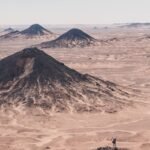
The Black Desert is one of the most important landmarks of the Bahariya Oasis. Located in the New Valley Governorate, it lies a little far north of the White Desert, closer to Bahariya Oasis than Farafra Oasis. The mountains here have eroded, covering the desert with a layer of black powder and rocks, giving the place its name. At the edge of the Black Desert, there are black volcanic hills that erupted in the past ages, producing a volcanic substance called jasper.
4. English Mountain
One of the highest peaks in the Black Desert, English Mountain offers an enchanting view of the landscape. It is a popular spot for tourists to climb and take in the panoramic views.
5. Al-Marsous Mountain
Al-Marsous Mountain is a volcanic crater covered with volcanic jasper, presenting a beautiful and historical landscape.
6. Panorama of Mountain
Visitors to the Black Desert often climb Panorama Mountain to capture stunning panoramic images of the area.
7. Farafra Oasis and the White Desert
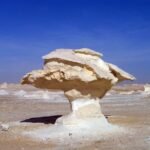
Farafra Oasis, the least developed of the Western Desert oases, is known for its tranquility and the White Desert. This area is famous for its surreal chalk rock formations, sculpted by wind and sand into bizarre shapes.
8. The White Desert
The White Desert, located in the Bahariya Oasis and north of Farafra Oasis in the New Valley Governorate, covers more than 3,000 square kilometers. It is named for its white, chalky landscape, contrasting sharply with the typical yellow and brown deserts. The White Desert is considered one of the most unique deserts globally, known for its towering white formations that make you feel as if you are walking through a sea of pure milk. The area is perfect for camping and safari trips, offering a magical experience under the starry desert sky.
9. Dakhla Oasis
Dakhla Oasis is known for its historical sites and beautiful landscapes. Visitors can explore ancient temples, such as Deir el-Hagar, and enjoy the scenic beauty of lush gardens and palm groves. The oasis is also home to several hot springs, perfect for relaxation.
10. Kharga Oasis
Kharga Oasis is the largest oasis in the Western Desert in Egypt and serves as the administrative center of the New Valley Governorate. It is known for its extensive history, with sites such as the Hibis Temple and the Bagawat Necropolis, which date back to the early Christian period.
Bahariya Oasis is a depression and a naturally rich oasis in the Western Desert of Egypt. With TravMe – Book Now Bahariya Oasis- Black and White Desert Trip
Adventure Activities in the Western Desert in Egypt
The Western Desert in Egypt offers a plethora of activities for adventure seekers. From exploring surreal landscapes to engaging in thrilling sports, this region is a paradise for those looking for excitement and unique experiences.
1. Sandboarding and Dune Bashing

The towering sand dunes of the Great Sand Sea are perfect for sandboarding and dune bashing. These activities provide an exhilarating way to experience the desert’s vast and undulating landscape.
2. Camel trekking

Camel trekking is a quintessential desert experience. Traversing the desert on camelback allows visitors to immerse themselves in the serene beauty of the Western Desert in Egypt while experiencing a traditional mode of transportation.
4. Hiking and camping
The Western Desert in Egypt offers numerous opportunities for hiking and camping. Whether exploring the rock formations of the White Desert or the scenic landscapes of the oases, camping under the starry desert sky is an unforgettable experience.
The Cultural Heritage of the Western Desert in Egypt
1. Prehistoric rock art
In the Gilf Kebir Plateau and other areas of the Western Desert in Egypt, visitors can find prehistoric rock art that dates back thousands of years. These petroglyphs depict scenes of hunting, dancing, and daily life, providing valuable insights into the lives of the ancient inhabitants.
2. Ancient Temples and Tombs
The Western Desert in Egypt is dotted with ancient temples and tombs that reflect the region’s historical significance. The Temple of Hibis in Kharga Oasis and the tombs of the Golden Mummies in Bahariya Oasis are just a few examples of archaeological treasures waiting to be explored.
Wildlife in the Western Desert
The Western Desert in Egypt is not just a barren wasteland; it is home to a surprising variety of wildlife. Despite the harsh conditions, numerous species have adapted to life in the desert, demonstrating remarkable resilience and adaptability. Visitors to the Western Desert in Egypt may encounter an array of animals, each uniquely suited to the arid environment.
When to Visit the Western Desert
The Western Desert in Egypt is a year-round destination, but the best time to visit depends on the type of experience you’re seeking and your tolerance for heat. Here’s a detailed guide to help you choose the ideal time for your trip.
Best Time to Visit: October to April
The cooler months from October to April are considered the best time to visit the Western Desert in Egypt. During this period, temperatures are more moderate, making it comfortable for exploring and engaging in outdoor activities.
Weather conditions:
– October to November: The autumn months offer pleasant weather with daytime temperatures ranging from 20°C to 30°C (68°F to 86°F). Nights can be cooler, with temperatures dropping to around 10°C to 15°C (50°F to 59°F).
– December to February: Winter is the coolest period in the desert. Daytime temperatures range from 15°C to 25°C (59°F to 77°F), while nighttime temperatures can drop to near freezing, around 0°C to 5°C (32°F to 41°F). This is an excellent time for hiking and exploring without the intense heat.
– March to April: Spring brings mild temperatures, similar to autumn, with daytime highs of 20°C to 30°C (68°F to 86°F) and cooler nights. This is another great time for outdoor activities and sightseeing.
Advantages:
– Comfortable temperatures for outdoor activities like hiking, camel trekking, and exploring ancient ruins.
– Cooler nights are ideal for camping under the stars.
– Fewer tourists compared to the peak seasons in other parts of Egypt, allowing for a more serene experience.
Off-Peak Season: May to September
The summer months from May to September are the hottest period in the Western Desert, with temperatures often exceeding 40°C (104°F) during the day. However, there are still reasons some travelers might consider visiting during this time.
Weather conditions:
– May to June: Early summer can still be bearable, with daytime temperatures ranging from 30°C to 40°C (86°F to 104°F). Nights remain warm, around 20°C to 25°C (68°F to 77°F).
– July to August: These are the hottest months, with daytime temperatures frequently surpassing 45°C (113°F). Nighttime temperatures can stay above 25°C (77°F).
– September: Late summer begins to cool down slightly, but temperatures can still reach 35°C to 40°C (95°F to 104°F) during the day.
Advantages:
– Lower travel costs and fewer crowds, offering a more intimate experience of the desert’s landscapes and historical sites.
– Enhanced opportunities for solitude and tranquility in popular tourist spots.
– Potential for unique photography opportunities with dramatic lighting and less haze.
- Considerations
– High temperatures require careful planning, with activities best scheduled for early morning or late afternoon to avoid the midday heat.
– Travelers should be well-prepared with ample water, sun protection, and light, breathable clothing.
Special Events and Festivals
Timing your visit to coincide with local events and festivals can enrich your experience. While the Western Desert itself doesn’t host many large-scale festivals, nearby regions and oases occasionally hold cultural events that can be fascinating to attend.
– Siwa Oasis Festivals: Traditional celebrations in Siwa, such as the Siyaha Festival in October, offer insights into local customs and heritage.
– Egyptian National Holidays: Traveling during major national holidays like Ramadan and Eid can provide unique cultural experiences, though it’s essential to be mindful of changes in local customs and business hours.
Tips for Visiting the Western Desert in Egypt
Regardless of when you choose to visit, here are some essential tips to ensure a safe and enjoyable trip:
– Stay Hydrated: Always carry plenty of water and drink regularly to avoid dehydration, especially in the hot months.
– Dress Appropriately: Wear light, loose-fitting clothing to stay cool and protect your skin from the sun. A hat, sunglasses, and sunscreen are essential.
– Plan Activities Wisely: Schedule outdoor activities for early morning or late afternoon to avoid the peak heat of midday.
– Prepare for Cold Nights: Even during the warmer months, nighttime temperatures can drop significantly. Pack layers to stay warm in the evenings.
– Travel with a Guide: Hiring an experienced guide is highly recommended for navigating the vast and sometimes challenging desert terrain. They can also provide valuable insights into the region’s history and culture.
– Check Weather Forecasts: Keep an eye on weather forecasts before and during your trip to anticipate any extreme conditions and adjust your plans accordingly.
By understanding the seasonal variations and planning your visit accordingly, you can make the most of your trip to the Western Desert in Egypt. Whether you’re seeking adventure, tranquility, or cultural
Holidays in the Western Desert in Egypt offer the perfect blend of adventure, relaxation, and cultural exploration. Whether you’re marveling at ancient wonders, traversing the sand dunes, or enjoying the tranquility of the oases, Egypt provides endless opportunities for fun. By understanding Egypt’s travel seasons and taking advantage of the best times to visit, you can ensure an unforgettable experience y. Start planning your dream vacation with TravMe, and discover why the Western Desert in Egypt is one of the best destinations for travelling. Happy travels from TravMe! Plan your trip and create memories that will last a lifetime.
Start planning your adventure to the Western Desert in Egypt with TravMe, and discover the magic of this ancient land together. Visit our website to explore our packages and find the perfect tour for you.
Business Information
– Phone: +201008833030
– Fax: +20233765560
– Email: info@travmetours.com
– Address: 5 Zohor St, Hadayek El Ahram, Elite Compound, Remaya Square, Giza, Egypt.
Read More
The Ultimate Guide to Exploring the Pyramids of Giza for 2024 | With Prices
Best Cairo Travel Guide – A Local’s Guide to Visiting Cairo | Updated 2024


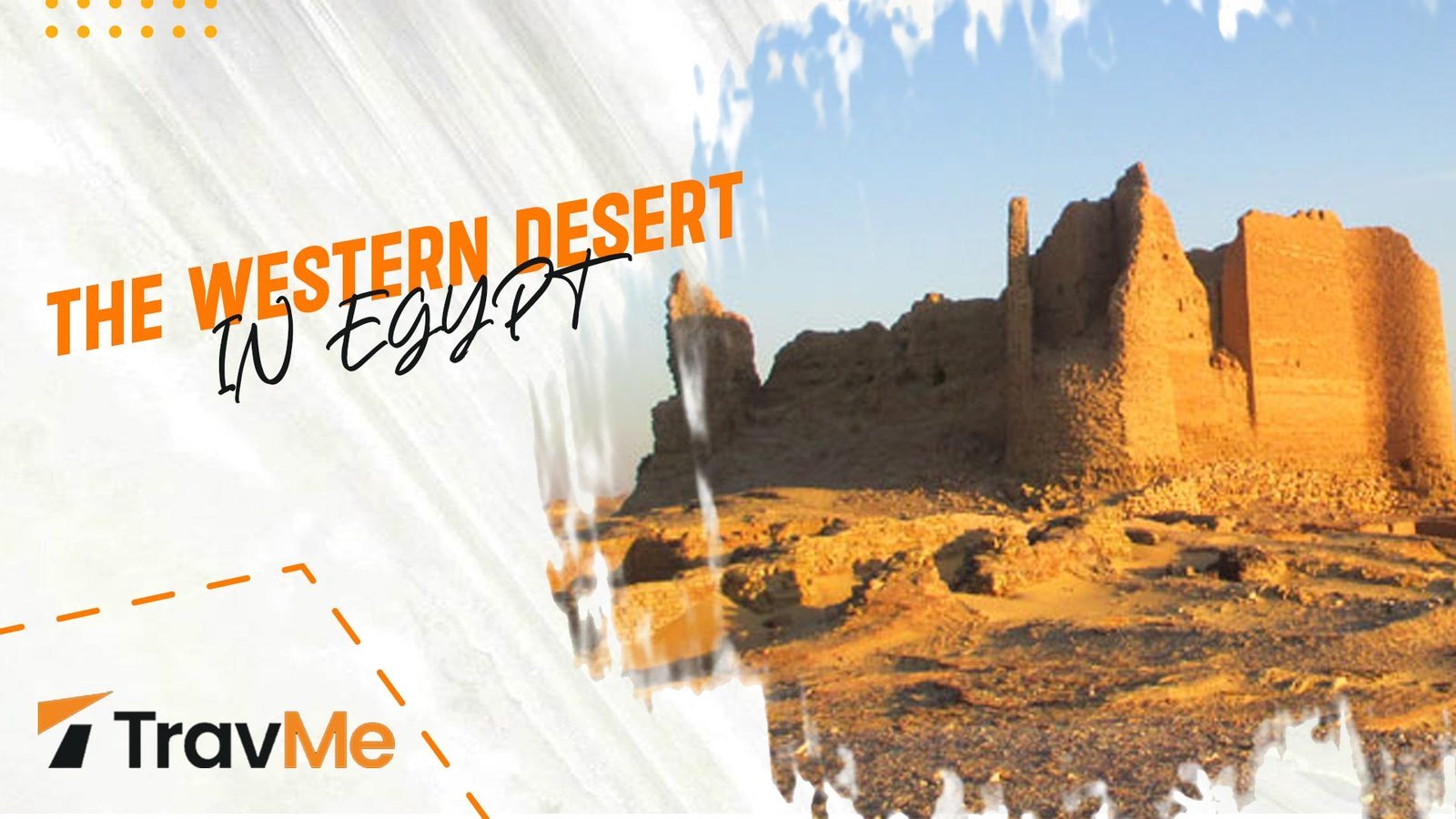
Comment (0)